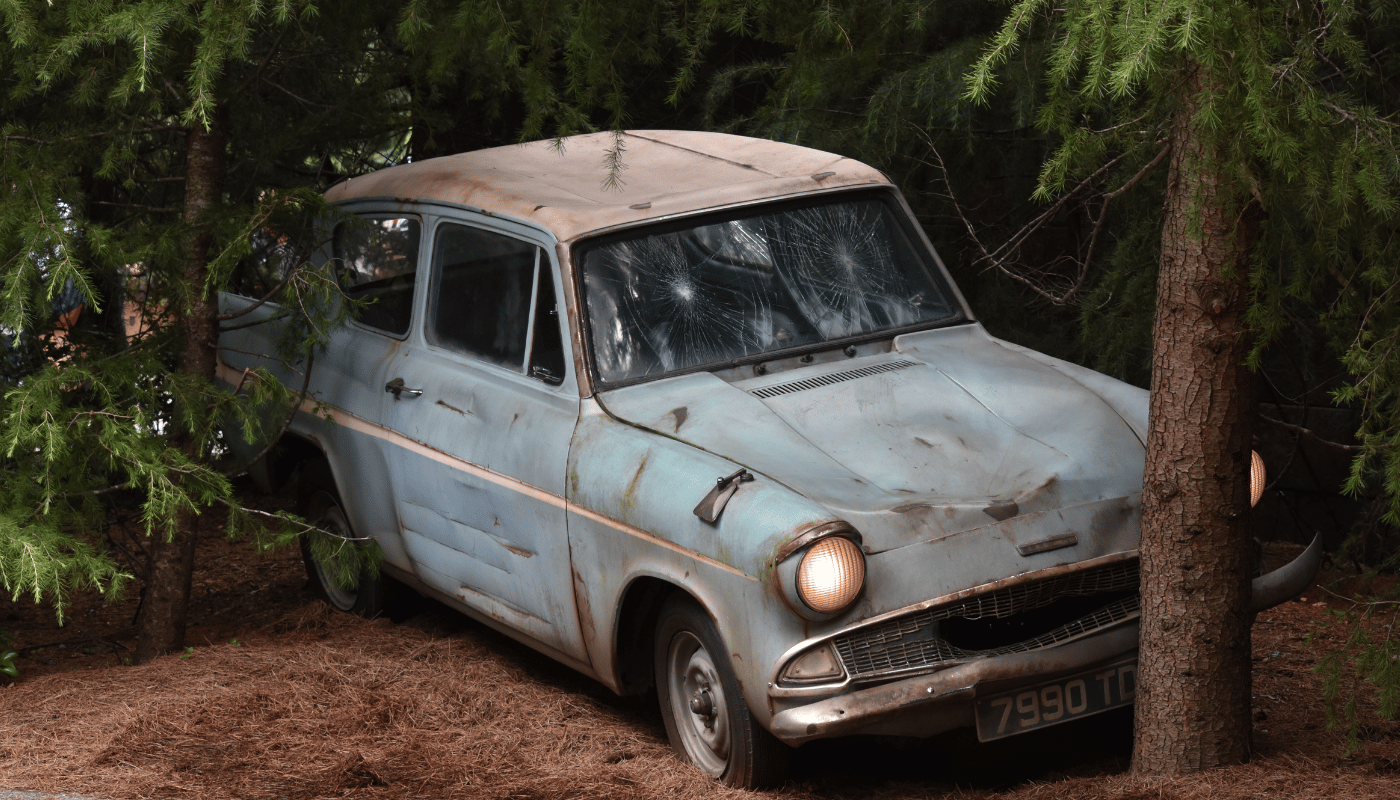The 2005 movie adaptation of “The Dukes of Hazzard” brought the iconic television show to a new generation, emphasizing the high-speed chases, airborne jumps, and near-miss crashes that fans loved in the original series. True to form, the film featured the General Lee—a customized 1969 Dodge Charger—as a central element of the action, tearing through scenes at top speeds, jumping over rivers, and evading police in a way that left a trail of destruction behind it. This commitment to real, practical stunts led to the extensive use of multiple vehicles for the production, resulting in a surprising number of car wrecks throughout filming.
Estimates suggest that 26 Dodge Chargers portraying the General Lee were wrecked in filming. These cars bore the brunt of the most daring stunts and complex driving maneuvers. Including other cars used in chases, like police vehicles and miscellaneous background vehicles, nearly 40 cars were damaged or destroyed by the end of production. This high number reflects the challenging, action-heavy scenes that were the heart of the movie and made a lasting impact on audiences.
The use of real vehicles and practical stunts gave the film an authentic feel, but it also drove up production costs and required a dedicated crew of mechanics and stunt drivers to keep cars functional—or ready to be swapped out—throughout the filming schedule. Here, we’ll take a closer look at why so many cars were needed, the types of stunts that led to their destruction, and the impact on car enthusiasts and fans alike.
Practical Effects and the Demands of Real Stunts
The decision to rely on real stunts over CGI was made to stay true to the original show’s roots. In the 1980s television series, the action and car chases were filmed with practical effects, and the producers of the 2005 film wanted to recreate this experience on a larger, more intense scale. This meant that every jump, every drift, and every crash in the movie involved real cars, real drivers, and real risk. Each scene required precise coordination and top-level stunt work to keep actors and crew safe while achieving the film’s high-octane energy.
When filming with real cars, even the smallest error or missed timing could result in an unintended collision or damage to the car, which would render it unusable for subsequent scenes. Stunt cars, particularly those performing jumps, were often only good for one take due to the structural strain and damage sustained from the landing impact. Some cars were reinforced with special cages to protect drivers, but these reinforcements did little to prevent damage to the car’s frame or engine when landing from significant heights or making sudden stops.
By the end of production, the film had gone through a staggering number of vehicles, not only because of the complex stunts but also due to the need for multiple takes to capture the ideal shot. Each jump or chase scene had to be perfect, and in many cases, this required more than one take and thus more than one car.
Sourcing the Dodge Chargers
The central role of the General Lee—a 1969 Dodge Charger—meant the filmmakers needed a large supply of these vintage vehicles. However, because the 1969 Charger was a classic muscle car and had not been manufactured in decades, locating a sufficient number of Chargers posed a challenge. To meet the demand, the production team sourced Dodge Chargers from various places, including car auctions, collectors, and used car dealerships. In some cases, Dodge Chargers from other model years were modified to look like the 1969 Charger, with specific details added to match the General Lee’s iconic orange paint, Confederate flag roof design, and “01” on the doors.
To add to the film’s authenticity, each Charger was modified to suit the needs of specific stunts. Cars that were set to perform jumps or crashes received reinforcements, such as roll cages, to protect the driver during impact, while others were altered to improve speed or agility for chase scenes. This intensive modification process required a team of skilled mechanics and fabricators who could adjust or repair the cars as needed, ensuring they were ready for each day’s shooting schedule. Despite these preparations, the intensity of the stunts often meant that each car could only survive a limited number of takes before being rendered unusable.
The rarity of the 1969 Charger and the high number of cars needed led to a mixture of creative solutions, including using similar models and adding reinforcements. But in the end, many of these cars were destroyed beyond repair due to the rigorous demands of the movie’s action scenes.
High-Impact Stunts That Led to Car Destruction
The stunts in “The Dukes of Hazzard” (2005) were designed to be thrilling, memorable, and visually stunning, which inevitably led to a high number of wrecked vehicles. Here are a few examples of the types of stunts that resulted in cars being destroyed during production:
- Airborne Jumps: One of the most iconic stunts in the movie involved the General Lee flying over rivers, ditches, and other obstacles, sometimes reaching heights of over 20 feet and distances of up to 150 feet. The impact of these jumps often bent or cracked the car’s frame, damaged the suspension, and, in some cases, destroyed the engine upon landing.
- High-Speed Chases: Many scenes involved high-speed chases between the General Lee and police vehicles, requiring tight turns, sudden stops, and collisions. Police cars used in these scenes frequently ended up crashed or severely damaged, adding to the overall car count.
- Rollovers and Crashes: Some stunts required the General Lee or police cars to roll over, crash into barriers, or collide with other vehicles. These intense stunts were often done in a single take, as the cars would sustain too much damage to be reused.
- Explosions and Special Effects: Certain scenes called for vehicles to be blown up or set on fire, rendering them completely unusable after the take. These scenes were choreographed carefully to ensure safety, but the destruction of the car was inevitable.
Legacy of the General Lee in Film
The General Lee holds a special place in American pop culture, and its role in the 2005 movie solidified its status as an iconic car. The vehicle’s powerful V8 engine, distinctive orange paint, and impressive stunts made it a fan favorite, drawing admiration from car enthusiasts and fans of the series. However, the high number of Dodge Chargers destroyed during filming sparked debate among car collectors and muscle car enthusiasts, with some lamenting the loss of so many classic vehicles.
Despite the criticism, the use of real Dodge Chargers added authenticity to the movie’s action scenes, and the legacy of the General Lee lives on. The car remains a symbol of high-speed action and daring stunts, cementing its place as one of the most recognizable vehicles in film history.
Financial and Logistical Challenges of Wrecking Cars
The financial impact of destroying nearly 40 vehicles, including 26 Dodge Chargers, was considerable. Car destruction was one of the most significant budget items, covering not only the purchase and modification of each vehicle but also the costs associated with replacing wrecked cars. Each Dodge Charger used in the movie came with the added cost of custom modifications for stunts, including protective cages, reinforced frames, and other adjustments.
For production logistics, maintaining a steady supply of functional cars presented a constant challenge. The high rate of destruction meant the mechanics team had to work quickly to prepare and repair cars for filming. The logistics involved in transporting, modifying, and replacing these cars required careful planning and coordination to avoid production delays.
Effects of Car Destruction on the Movie’s Reception
The decision to wreck so many Dodge Chargers was met with mixed reactions from audiences. Fans of the original series appreciated the authenticity and dedication to real stunts, while car enthusiasts viewed it as a sacrifice of valuable classic vehicles. The movie’s reception highlighted the trade-off between achieving genuine action sequences and preserving automotive history, raising questions about the balance of these priorities in filmmaking.
However, the destruction of so many cars in “The Dukes of Hazzard” added a layer of realism that CGI alone could not achieve, making it a visually impactful and memorable experience for viewers. The attention to detail in the stunts and the use of real vehicles made the movie stand out in a time when CGI was becoming the industry standard for action scenes.
Car Use and Destruction
| Vehicle Type | Total Cars Used | Estimated Number Wrecked | Purpose in Film |
| Dodge Charger | 30 | 26 | Used for stunts as General Lee |
| Police Vehicles | 12 | 10 | Chase scenes, collisions |
| Miscellaneous Cars | 10 | 4 | Background scenes, minor roles |
| Total | 52 | 40 |
Popularity of Dodge Chargers in Hollywood
The Dodge Charger has featured prominently in other Hollywood productions, particularly in movies known for high-octane chases and action scenes. The car’s build and design make it ideal for stunts, withstanding the demands of action-packed sequences. However, the number of Chargers destroyed in “The Dukes of Hazzard” is among the highest on record, contributing to the model’s legendary status among action-movie vehicles.
Other films, like “The Fast and the Furious” series and “Bullitt,” have also popularized the Charger, although not to the extent of wrecking as many cars. Hollywood’s attraction to the Charger underscores its role as a symbol of American automotive power, making it a popular choice for directors looking to portray strength, durability, and speed.
Types of Damage Sustained by Cars
The demanding stunts in “The Dukes of Hazzard” put severe stress on the vehicles used, resulting in a range of damage types that rendered many cars unusable after filming. The extensive use of practical effects caused damage that varied based on the specific requirements of each scene.
- Frame Damage: Many cars suffered structural damage, including bent or broken frames, after high jumps and crashes.
- Engine and Transmission Failure: Cars used for high-speed chases and sudden stops often experienced mechanical failure.
- Suspension Wear and Tear: The shocks and suspension systems took a beating from jumps and rough landings, which significantly impacted the cars’ durability.
- Body Damage: Crashes and collisions left dents, scrapes, and broken parts across the vehicles.
The Financial Cost of Wrecking Cars
The financial impact of wrecking dozens of vehicles was substantial. While some of the cars used were sourced affordably, particularly the police cars and background vehicles, Dodge Chargers came at a higher price. Each Charger not only needed to be sourced but also modified and prepared for the stunts required by the film. Costs included repairs, customization, and the work of the crew responsible for modifying and maintaining each car.
However, the decision to use real cars was seen as essential for achieving the movie’s desired visual effects. Although CGI could have saved costs by reducing the number of cars destroyed, it wouldn’t have provided the same authenticity or impact. The production team believed that these real effects were worth the investment, as they played a crucial role in capturing the essence of the original series.
Long-Term Impact on Car Collectors and Fans
The destruction of so many Dodge Chargers in “The Dukes of Hazzard” created a lasting impression on car collectors and fans of classic muscle cars. While the movie brought the Charger back into the spotlight, it also reduced the number of vintage models available. Some fans appreciated the authenticity of the stunts, while others lamented the loss of so many rare vehicles.
The General Lee’s iconic status helped bolster the Charger’s popularity in car culture, making it a highly desirable model among collectors. Although many Chargers were sacrificed for the movie, the car’s legacy has only grown, fueled by its role in one of Hollywood’s most car-centric films.




Leave a Reply